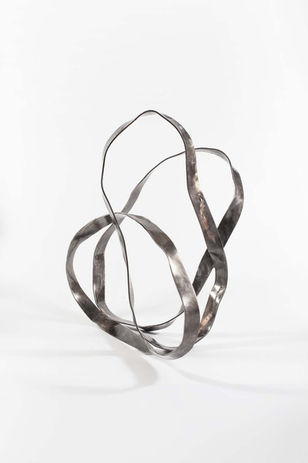
Obscurity of Oblivion
Solo exhibition
2017 | Artists house TLV | Curator: Arie Berkovitz
Obscurity of Oblivion
(Doron Polak)
Rami Ater’s sculptures are firmly rooted in the ground but their sisyphean essence points to infinity.
The metal pieces of this exhibition deal with forgetfulness, mainly in its allegorical characteristics and the viewer’s interpretation. Forgetfulness can be explained in three different but complementary directions. The objective process forced by nature, the subjective will, where one chooses forgetfulness as an escape, and the subjective involuntary path where forgetfulness is imposed by another subject.
Ater is an expressive artist and any interpretation of his work must be based on this premise. His life, the people around him – those still here and those gone – effect the essence of his art and outline his statues. Sometimes the absent in them shapes the existing, and the full mass defines and even creates the environment enveloping the piece. Ater’s previous exhibitions formed the foundation for this project. Like Peter Brook’s Empty Space Theory, in which he claimed that the space is as important as the matter filling it, Ater creates a language with unclear boundaries, inviting the spectator to interpret the dialogue between the visible real material to the empty space forming in it.
Using movement is one of Ater’s signature construction mediums. His statues promptly open up a dialogue with the viewer, inviting him to immerse in them, whether by conscious choice of a hypnotic process or coerced by a magnetic-like force. Each piece has its own character and form, each represents the artist’s state and expression of mind in the artistic process. The statuses’ symmetry and a-symmetry render the person looking at them both the subject of the riddle and its solver, emphasizing the tension between the deliberate and the spontaneous in meta-creation, as a tool within the process, the object and the viewer. Iron as a plastic-elastic material is testimony of its own molding and the powers used in its molding. Scars and marks on its surface are evidence of the spontaneous intervention of inanimate and organisms, whose existence can only be speculated on in the process of creation. However, this is incomplete – a second hand memory bringing forth the inherent mystery in observing the other’s consciousness spectacles. The viewer’s place in front of the iron poses a question about remembering and forgetting within the self-observing subject: is there a memory that is not second-hand?
Ater adds yellow specks of brass to his metal creations, compromising the perfect
unison of shade on the one hand, while, on the other hand creating a dramatic tension inviting the spectator to face a mysterious enigma. Alien to the color of iron, these specks can be evidence to an intentional and aggressive act of blurring and dulling, an act of erasing from memory that are also indicative of aging, tattering and fading, much like the effect of time over memory. However, unlike rust eating away at iron over time, the speck makes itself present, demands attention to its unnatural appearance, metaphorically drawing our attention to the intentional distancing of memory from consciousness, which creates a forced and annoying testimony of that distancing that can very well be intentional. Man reminding himself of things he had made himself forget. The twisting of the iron corresponds with the formative image of the neural, attributed to thought’s biological form. This is also a metaphor of memory organization, whereby memory seeks to imprison man’s twisted sequence of experience in a defined directionality with countless emotional vectors. More than anything, this constructive tangle created by the statues’ “body language” speaks to the complexity of man’s life plot and the compulsive need deriving from it: organizing, sorting and defining the end of memory and the beginning of forgetfulness. Ater’s use of the language of sculpture to express personal and social sensibilities results in a tapestry of criticism and an original and forceful reference of what is.
Rami Ater’s constructive creations are reference of the 1920 Realistic Manifeso of Constructivism, which defined art as realizing perception through shaping space and time. “We construct our creations in the same way the universe constructs its creations, the engineer builds his bridges and the mathematician develops the formula for star orbits... “Ater’s constructive sculpture, like mythical statues throughout the history of sculpture, are simply designed entities; they are objects in their own right, by their own rules, but they are charged by the confrontation between these inherent rules and the laws of movement and time, which are external to them.






























